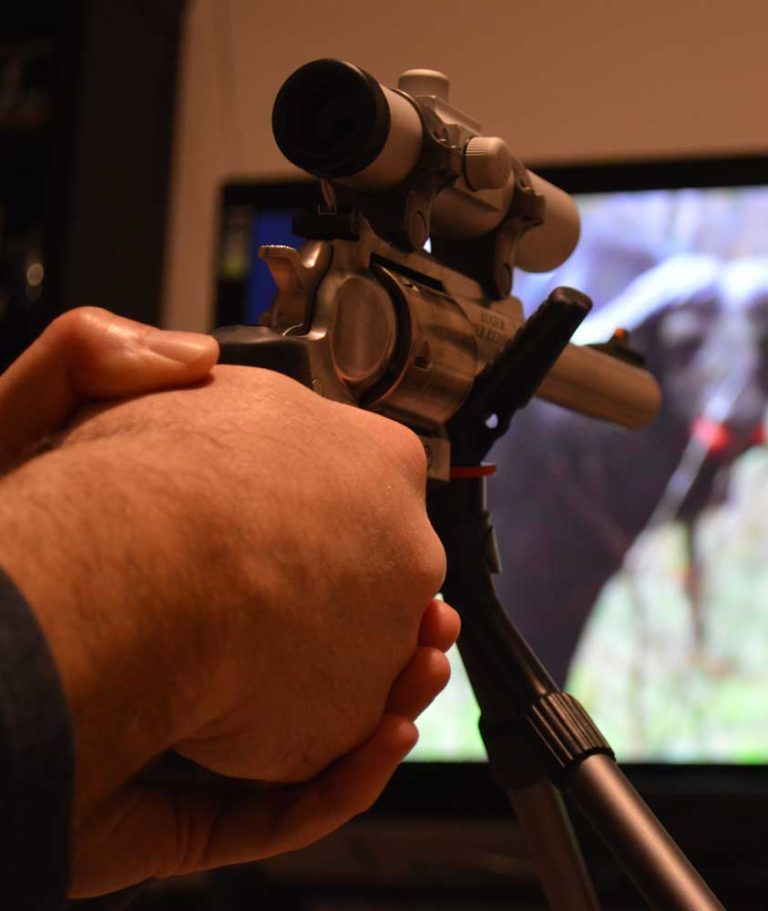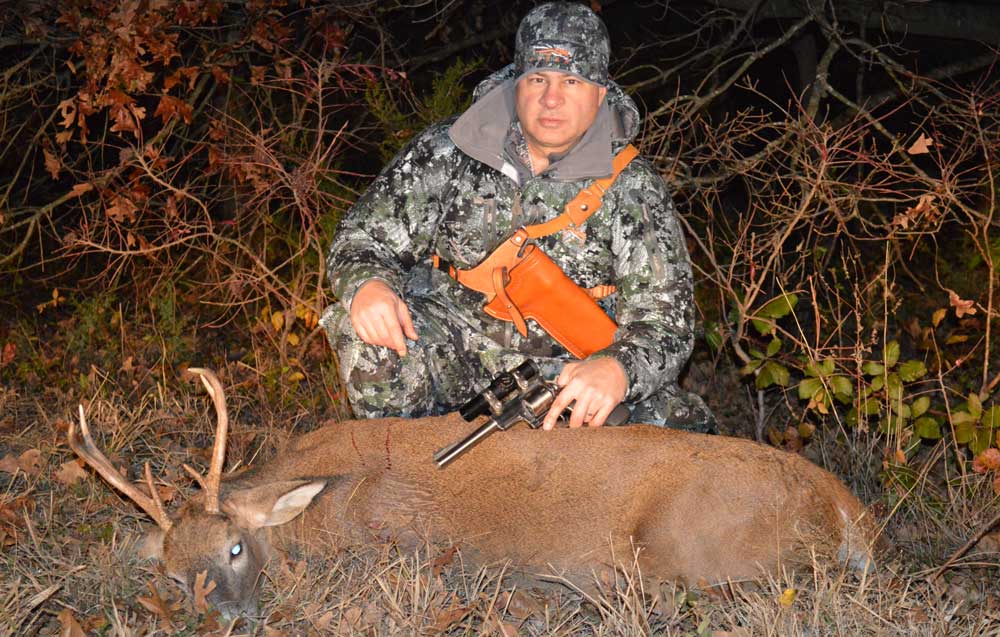


Finding a hunting revolver that suits you well is critical. Comfort goes a long way to building confidence. Should you choose a single- or double-action? .357 Mag. or .44 Mag? .454 Casull? Long barrel? Short barrel? Scope? Open sights? What configuration will fulfill your needs?
There are a number of questions you need to answer honestly to zero in on what will best serve your big-game hunting aspirations. If at all possible, you should try a number of different potential hunting revolvers. Recoil characteristics vary greatly between the different types and makes, and let’s face the facts, large-caliber revolvers deliver sizable recoil.
Double-action revolvers tend to concentrate recoil force straight back into the web of your hand, while single-actions tend to twist upward, sparing the shooter some of the unpleasantness. The two configurations are worlds apart in how they transfer recoil to the shooter.
I could go into the various single-action grip-frame profiles, but we don’t have room for that here. My personal favorite is Ruger’s take on the Bisley grip frame, as it is optimal for control in my hands because it has more of a double-action-like recoil dynamic. Freedom Arms’ Model 83 grip is another that I really like.
I would again recommend testing out a few of the different makes, models and calibers before you make this decision. If you don’t know anyone with a variety of revolvers to try, I would suggest joining any number of websites that are dedicated to revolvers and handgun hunting. You may find someone local who is willing to let you shoot some of their guns.
Everyone has different preferences, so there are no hard and fast rules when it comes to picking a platform. For me, single-action revolvers point more intuitively than double actions. They are almost an extension of the hand. Gunslingers of the Old West were undoubtedly well aware of this handling characteristic, relying on point-shooting for survival. On the other hand, we are not gunslingers but handgun hunters, and the double action may offer some advantages when quick follow-up shots are needed to dispatch a departing animal.

This is as good as any time to briefly discuss calibers. While the .357 Magnum is not my first choice, it can be effective. Remember that shot placement is key, and a half-inch hole won’t make up for lousy marksmanship. Loaded with a quality bullet, I wouldn’t hesitate to use the .357 Mag. on deer. However, I still prefer erring on the larger side with regard to calibers. The .41 Magnum is a good starting point and compromise, though factory ammunition is somewhat scarce. The champion of all big-revolver rounds from an ammunition availability standpoint is the ubiquitous .44 Magnum. No other caliber can boast the sheer variety and quantity of available ammunition, and it is fully up to the task of taking any and every game animal that has ever walked the face of this earth.
One of my personal favorites is the .45 Colt — yeah, that old black-powder cartridge from the late 1800s. It can be loaded considerably hotter than its original configuration (limited to 14,000 psi). I’m not suggesting turning your .45 Colt into a .454 Casull, but revolvers like Ruger’s Blackhawk in .45 Colt are considerably stronger than a Colt Single Action Army or the many facsimiles available on the market and are able to safely handle considerably hotter loads than the 14,000-psi maximum imposed upon the smaller and more fragile revolvers. Adhere to published load data, and do not exceed the maximums recommended by the manufacturer, as there is no need to turn your favorite hunting revolver into a hand grenade.
There are quite a few big calibers that are fairly brutal to shoot, and I don’t recommend them to the neophyte. There are some, such as the .480 Ruger, that offer a fine compromise between power and recoil. However, you can load the big calibers down to “soft” levels and they still offer a sizable advantage over their smaller siblings. They don’t need to be pushed hard to be terminally effective. Keep this in mind when you are deciding on a caliber for a hunting revolver.
You need to be honest with yourself as far as your limitations. There is no shame in a low tolerance for recoil. These big-bore revolvers can be very difficult to shoot, as you generally have only 3 pounds to contain the considerable recoil generated by some cartridges. Take pride in being able to shoot your chosen hunting revolver well and effectively. Let someone else’s ego dictate their caliber choices. Confidence and competence will go a long way to filling the freezer with game meat. Confidence follows competence, and consistent competence is the offspring of practice.
Editor's Note: This article is from Gun Digest Book of Hunting Revolvers.

Next Step: Get your FREE Printable Target Pack
Enhance your shooting precision with our 62 MOA Targets, perfect for rifles and handguns. Crafted in collaboration with Storm Tactical for accuracy and versatility.
Subscribe to the Gun Digest email newsletter and get your downloadable target pack sent straight to your inbox. Stay updated with the latest firearms info in the industry.

![Best Concealed Carry Guns In 2025 [Field Tested] Wilson Combat EDC X9S 1](https://gundigest.com/wp-content/uploads/Wilson-Combat-EDC-X9S-1-324x160.jpg)


![Best 9mm Carbine: Affordable PCCs [Tested] Ruger Carbine Shooting](https://gundigest.com/wp-content/uploads/Ruger-Carbine-Shooting-100x70.jpg)

